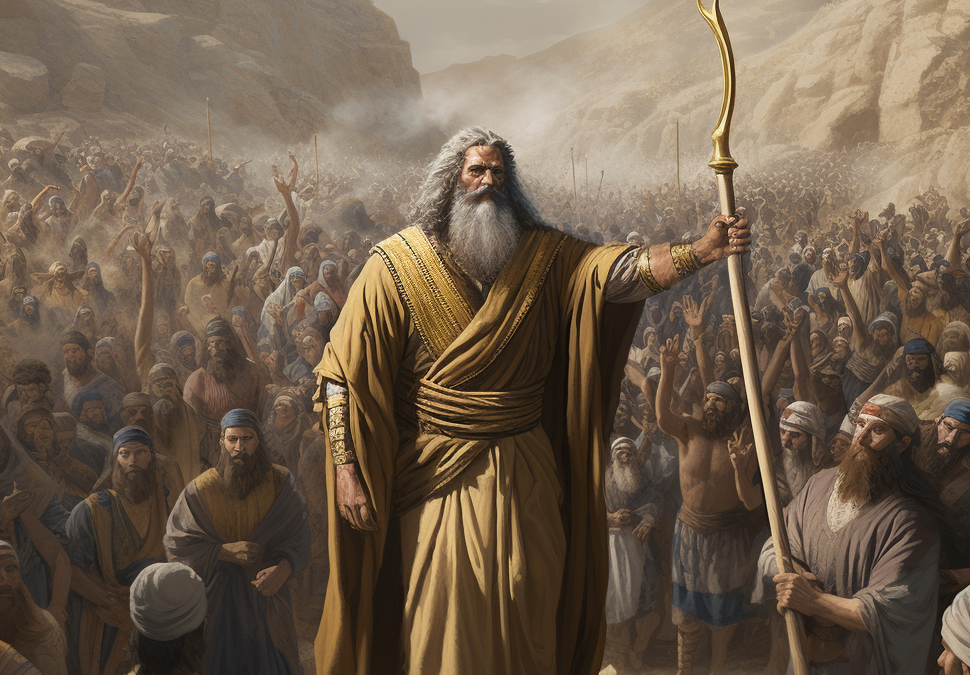Christians are well aware of the story of Moses and the ten plagues that God sent upon Egypt to free His people from slavery. However, what many may not know is that these plagues were not just a strategic attack against Pharaoh himself, but also a deliberate strike against the gods worshiped by the Egyptians.
Each plague was specifically designed to undermine one or more deities in their pantheon, demonstrating that only God has true power over all things in heaven and on earth. This surprising detail sheds new light on this ancient event and highlights how God used every means at His disposal to show His sovereignty.
The Egyptians worshiped various gods who they believed controlled different aspects of their lives, such as the Nile River, agriculture, animals, and even death. Each plague that occurred was designed to discredit one or more of these gods.
Through these plagues God demonstrated His superiority over all other so-called “gods”and proved that he alone is worthy of worship and praise.
1st Plague of Blood (Exodus 7:14-25)
The first plague of turning the Nile River into blood was an attack on several Egyptian gods including Khnum, Hapi, and Osiris.
The Egyptians believed that the Nile river was a source of life for their land as it provided water for agriculture and drinking. They also believed that various gods controlled different aspects of the Nile such as its fertility, fish abundance and overall health.
By turning the Nile to blood, God demonstrated His power over these “gods” who were unable to prevent this devastating event from taking place. It showed the Israelites that there is only one true God who has control over all things in heaven and on earth.
2nd Plague of Frogs (Exodus 8:1-15)
The second plague of overwhelming frogs was an attack on Heqet, the goddess of fertility and birth who had the head of a frog. The Egyptians believed that Heqet was responsible for ensuring successful births and promoting fertility.
However, by sending an overabundance of frogs into Egypt, God demonstrated His power over this so-called “goddess” who could not prevent or control this event. It showed that only God has true power over life and death.
3rd Plague of Lice & Gnats (Exodus 8:16-19)
The third plague of lice and gnats was an attack on Geb, the god of earth and inhabitable lands. The Egyptians believed that insects sprouted from the soil and that bad soil created these terrible and annoying creatures.
Through this plague, God demonstrated His power over Geb who could not control or prevent this event. It showed that only God has true power over all things in heaven and on earth, including creation.
4th Plague of Blood Sucking Flies (Exodus 8:20-32)
The fourth plague of flies was an attack on Uatchit or Wadjet, the goddess of lower Egypt who was associated with marshes and papyrus plants.
The Egyptians believed that this goddess kept these blood-sucking insects at bay. However, through this plague, God demonstrated His power over Uatchit who could not prevent or control the infestation of these harmful creatures. It showed that only God has true power over all things in heaven and on earth.
5th Plague of Sick Livestock (Exodus 9:1-7)
The fifth plague of sick cattle and livestock was an attack on Hathor, the goddess of love, beauty, fertility, music, and dance who had the head of a cow. The Egyptians believed that Hathor protected their cattle and livestock from disease.
Through this plague God demonstrated His power over Hathor who could not prevent or control the sickness that befell these animals. It showed that only God has true power over all things in heaven and on earth.
6th Plague of Boils (Exodus 9:8–12)
The sixth plague of boils was an attack on several Egyptian gods including Sekhmet, the goddess of disease and healing; Isis, the goddess of health; and Imhotep, who was considered a demigod of medicine.
The Egyptians believed that these gods had power over disease and could heal those who were afflicted. However, through this plague God demonstrated His power over them by afflicting both people and animals with painful boils that caused great suffering.
7th Plague of Thunderstorms and Hail (Exodus 9:13–35)
The seventh plague of thunderstorms of fire and hail was an attack on several Egyptian gods including Nut, the goddess of the sky; Set, the god of thunderstorms; and Shu, who was considered a god of air and supporter of the sky.
The Egyptians believed that these gods had power over natural disasters such as storms. However, through this plague God demonstrated His power over them by sending down destructive hailstones that caused great damage to crops and property.
8th Plague of Locusts (Exodus 10:1–20)
The eighth plague of locusts was an attack on several Egyptian gods including Osiris, who was considered the ruler of crops; Neprit and Nepit, the god and goddess of grains respectively.
The Egyptians believed that these gods had power over agriculture and could protect their crops from harm. However, through this plague God demonstrated His power over them by sending swarms of locusts that destroyed all vegetation in their path.
9th Plague of Darkness (Exodus 10:21–29)
The ninth plague of darkness was an attack on several Egyptian gods including Ra, who was considered the most revered god of the sun; Atum and Kephri, who both represented different aspects of the sun; and Horus, whose eyes represented the bright light in the sky with his right eye being associated with the sun.
The Egyptians believed that these gods controlled various aspects of nature including light. However, through this plague God demonstrated His power over them by shrouding Egypt in complete darkness for three days.
10th Plague of Death to the First Born (Exodus 11:1-12:36)
The tenth and final plague of the death of the firstborn was an attack on all 2000 gods in the Egyptian pantheon who were involved in life, death, and the afterlife. It was also a strike against Pharaoh himself who was believed to be a living god upon earth.
Conclusion
The Egyptians believed that their gods had power over life and death. However, through this plague God demonstrated His ultimate power over them by striking down every firstborn son in Egypt including Pharaoh’s own son.
The ten plagues of Egypt were not just a demonstration of God’s power, but also a strategic attack on the gods worshiped by the Egyptians. Through these events, God showed that only He has true authority over all things in heaven and on earth. The courage and commitment of Moses played an essential role in this story as he led his people out of slavery and towards freedom under divine guidance.
Moses was chosen by God to be His instrument for bringing about the liberation of Israel from bondage in Egypt. Despite facing countless obstacles along the way, including Pharaoh’s stubbornness and resistance, Moses remained steadfast in his faith and trust in God. He fearlessly confronted Pharaoh time after time with unwavering determination until finally achieving victory through God’s miraculous intervention.
The story of the ten plagues reminds us that our ultimate hope lies not in human strength or ability but rather in trusting completely in God who has control over every aspect of our lives. As Christians today we can learn from Moses’ example about serving others selflessly even when it requires great sacrifice because ultimately it pleases our Heavenly Father.

